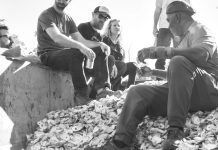
13 Questions is a weekly series where we ask chefs 13 questions to get to know them outside of the kitchen. Steven Satterfield is the chef and co-owner of Miller Union.
What’s one dish you wish you knew how to cook?
Persian rice. I’ve read a couple of recipes, and I’ve talked to someone who is Iranian. He’s very specific about how it should be done, so many steps and rules on how it’s made.
What do you do when you aren’t cooking?
I love to cycle. I’m definitely a fair-weather cyclist, spring and fall. I really like to travel and cook in other places. I’m about to go to Mexico, and I’m cooking in Tulum. I’m really looking forward to immersing myself in their ingredients and seeing what comes up. I like cooking with other people and collaborating. You always learn something, and it makes me grow faster than I would on my own.
Is there one vegetable you can’t stand?
I am not a big fan of green bell peppers, but they have their place. You would not have the flavor of Creole cooking without them. I don’t like them on their own because they’re underripe and bitter to me. They were way overused in the 1990s. But they grow so well here that we can’t ignore them, so I’m finding new ways to use them.
You studied architecture, then were in the band Seely. How’d you get to cooking?
When I was a kid, my grandfather was an architect, and I was super into that idea for a long time and also very drawn to music. But architecture seemed more like a real career, and I was good at science and math. But once I really immersed myself in it, it wasn’t in my heart; it felt like something I should do. One of my first jobs was at Oxford Books. I worked at same time as Linton Hopkins. Then I worked at Eats for four to five years, while the band was playing around town, trying to get signed. We got signed in 1995, made record in 1996. After Eats, I was at a vegetarian cafe called Homage, the Universal Joint, joined Floatway Cafe in 1999 right after they opened. I wasn’t there long because we went on tour. Our record came out that year, and we broke up six months later. That’s when I wanted to be more food focused, so I got a job working for Scott Peacock at Watershed for 10 years and cut my teeth there.
What cookbook influenced you the most?
One of the most inspiring cookbooks to sit down and read is The Taste of Country Cooking by Edna Lewis. It’s hyper-seasonal, poetic, and really beautiful. For writing, Amanda Hesser’s writing from the New York Times. For the voice and how brilliantly she does it, Gabrielle Hamilton’s Prune. It’s just so funny to read, and there’s lots of little notes and nuance about the food. Nigel Slater’s Tender was a huge inspiration for Root to Leaf. They’re very similarly organized, but his book includes gardening. I wanted to be like the American version of his book.
Who is your role model?
Scott Peacock was a big influence on me. He’s very particular, pretty strict about his style and standards. I also really look up to Nigel Slater. He’s very smart in how he thinks about food.
What was the last TV show you bingewatched?
I’ve been super into that new network Viceland. There’s three shows I like: Noisey explores culture around certain music movement and a certain place, in Balls Deep this guy immerses himself in a foreign culture but in America, and in Gaycation Ellen Page and Ian Daniel go to a foreign country and explore the gay scene.
What’s your guilty pleasure fast food?
I could just eat Mexican every single day. I love spicy foods. I like the acid of lime. I love cilantro. I like tacos. I love margaritas. I love beans and rice.
What was the first song you learned to play on the guitar?
I was 21 when I taught myself the guitar, but I didn’t learn by playing songs; I played intuitively. One of the first songs I learned to play was a song I wrote. Today, I don’t really have time. I am constantly at the restaurant or working on menu ideas. I am always in chef mode, but if I have a long flight, I’ll start playing around on Garage Band. I’ve written 20 different song sketches on it, electronic, dancey stuff.
Has your architecture degree ever been useful in the kitchen?
I think architecture school really forced me to tap into the creative side of my brain and use it as a resource and to trust my instincts and to be pragmatic about my choices. You have to think about what’s going to really stand up, can it be made again and again, is it structurally sound. [And it taught me] the long hours, tedious work that takes a long time to produce, discipline in general.
What do you miss the most about your hometown, Savannah?
Savannah just has such a great history that’s very intact. People that live there are well aware of the history there and the architecture. It’s close to the beach. I miss that vibe; it’s just a little slower. We have a house on Tybee Island. I like to cook a lot down there—shrimp, crab, oysters.
What was your first concert?
U2 The Unforgettable Fire. I was 15, and it was in Jacksonville, Florida. We had to drive two hours to get to the show.
Is there one Southern dish you have yet to master?
Shad roe. Shad is the boniest fish in the world. There are only two people left that knew how to fillet it. I never learned how to fillet a shad. It’s an oily fish that’s not for everybody. But it’s something people grew up eating, and it kind of fell away.
Miller Union chef Steven Satterfield’s cookbook is called Root to Leaf: A Southern Chef Cooks Through the Seasons—and that’s precisely what he’s doing for Atlanta magazine’s HOME in a series of videos. Satterfield’s cookbook is divided by season, and he offers recipes that are based on the bounty of each season. Watch:













